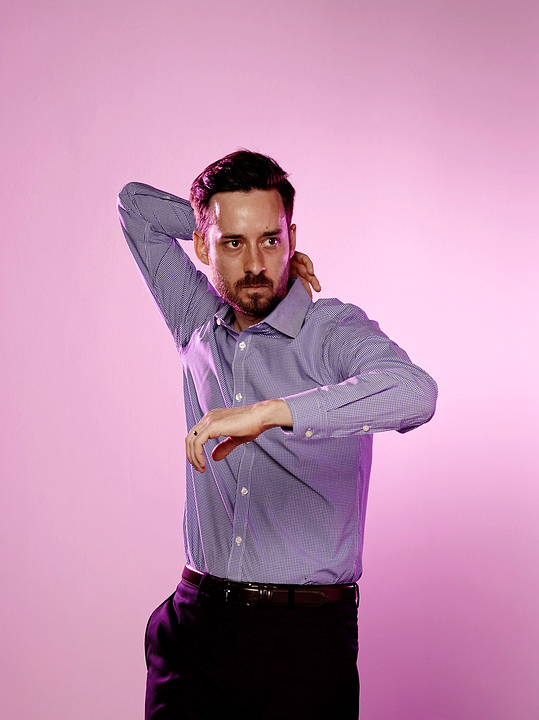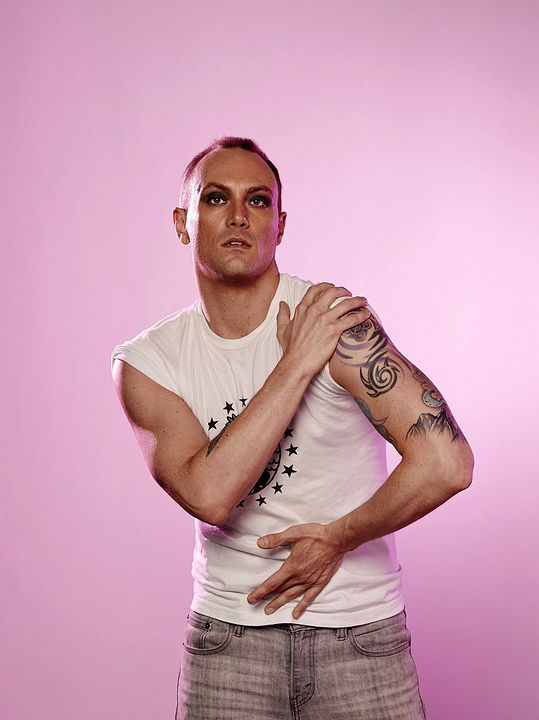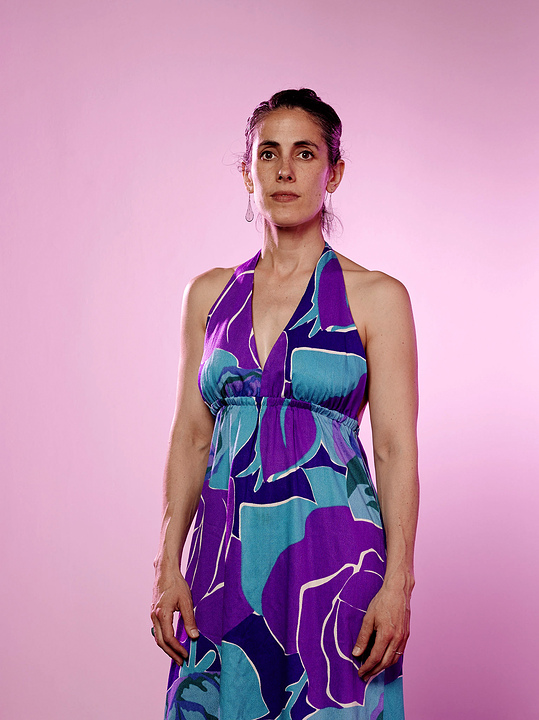Dancing the Brave New World
Curator and writer Mary Coyne reviews the new works featured in this year's Momentum showcase, by Luke Olson-Elm, Hiponymous, Nic Lincoln, and Angharad Davies.

Over the course of two weekends in July, four new evening-length choreographic works were presented at the Southern Theater. The dance makers were chosen by a panel of dance and performance figures in the Twin Cities, including Michele Steinwald and the Walker Art Center’s Philip Bither. Drastically different, the four works that made up this year’s Momentum festival represented the diversity and strengths of Twin Cities dance, and made for interesting and informative comparisons across and within the evenings’ performances.
Coming into the event, Hiponymous’ (Renee Copeland and Genevieve Muench) State of the Moon Address was highly anticipated. Having seen a section of the work presented at the 9 x 22 dance lab earlier in the spring, I held my own expectations and interest in seeing the complete work. At 9×22, the section was fun, playful and critically smart; having seen the work in part, I was eager to see how the excerpt fit into the rest of the narrative. In their artist’s statement, Hiponymous explains that “our concern is that this place is not suited for living, a culture with no viable citizens.” The scene they set is somewhere between a post-apocalyptic version of current society and the terrain of another planet. AstroTurf-covered mounds, standing stage lamps, and gray, factory-type uniforms together make for a Tim Burton-esque landscape at once whimsical and disturbing. The society in which Copeland and Muench are situated is strictly controlled and regimentedly performative. The joyful exchanges between the two dancers, their playful skipping, leaping, and the loving care with which they trim and shape the grassy mound, suggest an almost absurd, unnatural happiness. In a captivating section near in the second half of the piece, Copeland and Muench appear transfixed by a television screen off stage. The audible, rapid changing of channels, or programs, is physically enacted with immediate effect in the dancer’s movements who quickly responded to the rhythms emanating from the screen.
It is in this engagement with media representation where Hiponymous shines. In an earlier segment, the pair enact a on-air communication between stereotyped male and female newscasters, exaggerating only slightly a deeply gendered exchange. Using off-stage sound effects and voice-overs, the section both develops our understanding of the society depicted in the piece while also making the connection that this disturbing utopia is not a far cry from the way we actually live now. Such segments in the work are clearly well-researched, footnoting key writers and thinkers in media, gender, and queer theories. Indeed, the content of the two sections noted above, with the addition of some of the existing opening choreography would have been sufficient to communicate the layered commentary that the piece, in its full evening-length, aspired to. The issues presented deserve time and development, yet the choreography lacked a strong narrative arc; the movements remained similar from the beginning to the end. This repetition may well have been an attempt to suggest the ongoing performative labor that defines life on this fictional planet, but I kept waiting for something more: a chance development in the relationship between the two dancers, or some further elaboration on the situation in which they find themselves. Both Copeland and Muench are strong dancers, and I yearned at times to see a bit more of the technical and stylistic variation within the choreography of which I know they are capable.

About Broken, the second work of the first evening’s line-up, explores the idea of a group, of individuals coming together physically, emotionally, and socially. Choreographer Luke Olson-Elm created the work on himself and five dancers who, before this, had not worked with him or with one another. The lack of synchronicity was evident, but not a flaw, as far as I was concerned. Instead, I found myself drawn to watching, even studying, one dancer’s movements, and then another’s ; their strong individualistic styles were precisely what I found captivating. Much like the first work of the evening, the choreography, for the most part, does not yet sustain the “evening-length” run-time, but it simmers with potential nonetheless. Beautiful moments appeared sprinkled throughout the choreography, especially in a final duet that seemed to capture in a few movements the affect of miscommunication, of interpersonal relationships that are almost but never quite there. Olson-Elm’s use of seven spotlights to create personal spaces for each of the dancers at the start and finish of the work was poignant (although the idea would have benefited from a stage that was completely dark outside those puddles of light). Finding these moments, and developing a understanding of the movement qualities of each dancers is what endures in my mind about this work; the actual choreography isn’t memorable, in and of itself, and too often was drowned under a demanding, harsh score. Coming away from the performance, I hold a fresh, deep appreciation for the movement qualities of dancers Alyssa Mann and Kacey Hauk, but I find I’m less sure how to define or communicate Olson-Elm’s choreographic style.

Personal style was not at all lacking in Nic Lincoln’s new work, Nothing Astonishes Men So Much as Common Sense and Plain Dealing. Bombastic, dramatic, and at times over the top, Lincoln’s work is a marvelously crafted and powerfully performed trio for himself and two Zenon dancers, Scott Mettille and Stephen Schroeder. Drawing its title from a passage by American individualist Ralph Waldo Emerson, the work takes on an acutely gendered struggle for identity. Lincoln’s choreographic play with animal movements and forms, interpreted expertly by all three dancers, allows each performer to find truly original and organic movements, while at the same leaving room for their reflections on the crude and barbaric in human behavior. The work speaks to the sometimes opposing theories of Darwinism and Transcendentalism that shaped early twentieth-century masculine identity. That this is the first major work Lincoln has created for a male cast is astonishing—the partnering and psychological sensuality imposed on their relationships was arresting to watch. The strength of the dancers alone was enough to allow the work stand on its own two feet as a dance piece, so the constant live accompaniment by Twin Cities-based vocalist and performer Venus DeMars felt superfluous and, at times, distracting. Although the inclusion of a transwoman into the mix of this otherwise all-male performance highlighted more layers in the work, to do with gender and identity, DeMars’s impressive vocals and reverberating guitar chords pulled attention away from the subtleties of the choreography — and those subtleties are worthy of close analysis.

Angharad Davies’s potent, all-female quartet provided a unexpected but moving contrast to Lincoln’s showing. Created in the months following the birth of Davies’s daughter over a year ago, the work deals with the sensation, and more acutely, the emotion of falling. Entitled The Scraps, the piece plays with displaced, repeated memories that, when reenacted, are absurd or impossible out of their original context. Alternately desperate, frantic, powerful, and tender, the movement and enacted emotions are almost too complex for words. Throughout the piece, the dancers, often with eyes closed, mime the content of memory — reducing bodily action to spare movements of the hands, cutting across time and space but in short. The effect is like seeing the panoply of memory condensed into a .zip file, some abbreviated and nearly inaccessible ghost of the original occurrence. Over the full length of the piece, the dancers seemed locked in these memories, neither visually nor physically acknowledging each other’s presence. There is, however, from the start, a shared consciousness in evidence, initiated as the dancers open by watching a performance of Pretend (2013), Davies’ precursor to The Scraps, which is projected on the upstage wall. A sense of unsaid but shared support is palpable throughout the work, with the dancers at times falling into the same movements, as in an early section where the women form a parallel line, swinging their arms in unison. The dancers’ evident bond, their ability to sense each other’s movements in space even with eyes closed, strikes me as a beautiful result of their having worked together for more than three years. That understated affinity is a key to the work’s depth of emotional content.
Megan Mayer, one of the dancers in The Scraps, talked in the post-performance Q&A of the fear and vulnerability that comes with dancing with one’s eyes closed. She noted how disturbing it could be to think of an audience watching her, aware of her every gesture, while Mayer herself is unable to look back, unable even to know entirely what her own body is doing or at what pace. This sense of trained, intentional risk, this shared moment of vulnerability and confidence, speaks loudly to the hours and energy that all the choreographers and dancers who participated in this year’s Momentum festival have invested to get here.
Mary Coyne is a curator and writer based in Minneapolis where she is the Cunningham Research Fellow at the Walker Art Center. Mary has curated exhibitions in Los Angeles and New York and is the founder of Pseudo Empire, a non commercial exhibition space in Brooklyn. She holds an M.A in Art (Curatorial Studies) from California State University Long Beach and an B.A in Art History from the University of Southern California.